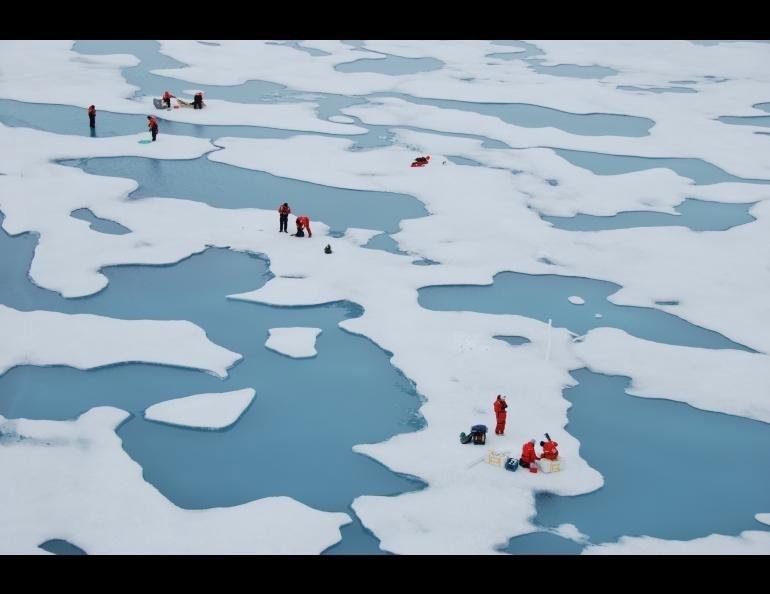A strategy to blanket Arctic sea ice with layers of tiny hollow glass spheres roughly the thickness of a human hair might actually increase sea-ice loss and warm the climate, rather than generating thick ice and lowering temperatures, as proponents say.

Scientists on the MOSAiC expedition work among Arctic melt ponds in 2020. Image Credit: Melinda Webster.
Sea ice helps in regulating ocean and air temperatures and controls ocean circulation by reflecting the majority of the sun’s energy back to space. Its surface area and thickness are essential to the Earth’s climate.
The new discovery was made as a result of a study headed by Melinda Webster of the University of Alaska Fairbanks Geophysical Institute. The findings were published in the journal Earth’s Future.
The study contradicts a claim made in a 2018 research report that repeated coating of hollow glass microspheres, or HGMs, to young Arctic sea ice would enhance reflectivity, shield it from the sun, and thus enable it to grow into highly reflective multi-year ice over time.
Webster’s research dismisses that assertion, revealing that layering white hollow glass microspheres onto Arctic sea ice would instead darken its surface, hasten sea ice melting, and warm the climate even more.
According to the 2018 study, applying five layers of HGMs reflects 43% of incoming sunlight while allowing 47% to flow through to the surface below. The HGMs absorb the remaining 10%.
According to Webster’s study, the microspheres’ 10% absorption of sunlight is sufficient to speed up ice melting and further warm the Arctic atmosphere.
Our results show that the proposed effort to halt Arctic sea-ice loss has the opposite effect of what is intended. And that is detrimental to Earth’s climate and human society as a whole.
Melinda Webster, Geophysical Institute, University of Alaska Fairbanks
Webster and Stephen G. Warren of the University of Washington analyzed variations in solar radiation across eight typical surface conditions seen on Arctic sea ice, each of which has a distinct reflectivity. Along with these factors, they took cloud cover, the response of the microspheres to sunlight, the intensity of solar radiation at the surface and at the top of the atmosphere, seasonal sunshine, and more into account.
They employed the same number of layers and types of microspheres as the 2018 study as the basis for their investigation.
The 2018 study did not adequately account for the various surface reflectivities or fluctuations that would emerge based on the time of year that HGM was applied.
A layer of microspheres can boost the reflectivity of thin new ice, which is normally dark, but the impact is small because thin ice usually arises in autumn and winter when there is little sunlight. Thin ice quickly becomes covered by falling and drifting snow, increasing its surface reflectivity.
With the return of the polar day in spring, solar energy increases. The majority of the sea ice is blanketed by dense, reflecting snow at that time. Because of snow's high reflectivity, microspheres will darken the snow surface, boosting solar absorption and thus accelerating melting—the inverse of what would be expected.
As solar energy intensifies in the late spring and early summer, melt ponds begin to appear throughout the sea ice. Given their darkness and low reflectivity, ponds would appear to be a prime target for the usage of hollow glass microspheres.
However, carpeting ponds with microspheres will not have the desired result. In an experiment on a Minnesota pond, the buoyant spheres were carried by the wind to the water’s edge, where they clumped together just the way pollen does every year on ponds and puddles.
The Bottom Line?
The months of March, April, May, and June, when sunshine is intensifying and would appear to be the best for the application of microspheres, are in fact the worst for applying HGMs.
Completely non-absorbing microspheres, which absorb 0% rather than 10% of incoming solar energy, may still be ineffective for the same issue that affects both forms of the tiny spheres: Quantity. If non-absorbing microspheres could be made and distributed without contamination, a yearly one-time application to cool the climate would require around 360 million tons.
The use of microspheres as a way to restore Arctic sea ice isn’t feasible. While science should continue to explore ways to mitigate global warming, the best bet is for society to reduce the behaviors that continue to contribute to climate change.
Melinda Webster, Geophysical Institute, University of Alaska Fairbanks
Journal Reference
Webster, M. A. & Warren, S. G. (2022) Regional Geoengineering Using Tiny Glass Bubbles Would Accelerate the Loss of Arctic Sea Ice. Earth’s Future. https://agupubs.onlinelibrary.wiley.com/doi/10.1029/2022EF002815